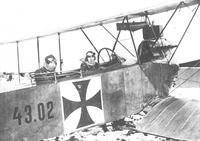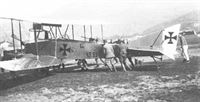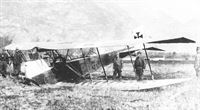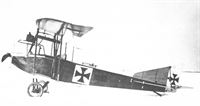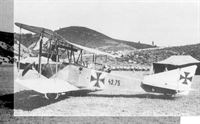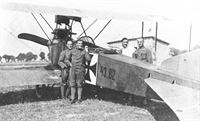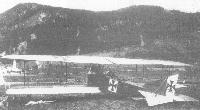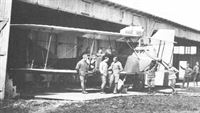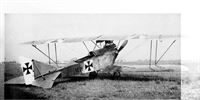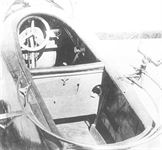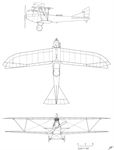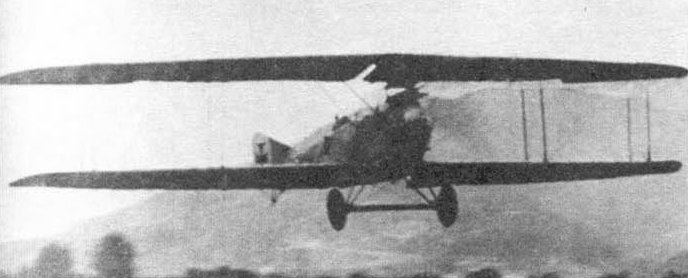
Описание
Страна: Австро-Венгрия
Год: 1915
Фронтовой самолет
В.Кондратьев Самолеты первой мировой войны
ЛЛОЙД C-II/C-III / LLOYD C-II/C-III
В начале 1915 года венгерская фирма Ллойд Флюгцойг унд Моторенфабрик развернула серийный выпуск двухместного многоцелевого биплана C-II. Этот цельнодеревянный аппарат со смешанной обшивкой отличался крыльями с ярко выраженной стреловидностью по передней кромке и дополнительными подкосами от фюзеляжа к верхнему крылу (позднее такая схема бипланной коробки была применена англичанами на их "полуторастоечном" "Сопвиче"). Экипаж размещался в общей кабине с трапециевидным вырезом.
Помимо завода фирмы Ллойд в Ашоде, C-II выпускался венской фирмой Винер Кароссерие унд Флюгцойгфабрик (WKF).
Оснащенный мощным 145-сильным мотором (на тогдашних германо-австрийских аэропланах в основном стояли двигатели в 100-120 л.с), "Ллойд" удачно сочетал в себе хорошие летные данные с простотой управления, характерной для большинства австрийских машин. Благодаря этому он нашел широкое применение в качестве разведчика на сербском и восточном фронтах. Единственным серьезным недостатком считалось отсутствие вооружения.
От этого недостатка избавились в следующей модификации C-III, разработанной в 1916 году. Кроме турельного пулемета, на нее установили еще более мощный мотор.
Новый "Ллойд" наилучшим образом подходил для боевых действий в горах Северной Италии. Он обладал высокой скороподъемностью, короткой взлетно-посадочной дистанцией и мог вполне устойчиво держаться в воздухе в условиях сильно возмущенной горной атмосферы.
Основная масса C-III применялась на итальянском фронте, но в 1917 году небольшое количество этих машин попало на румынский фронт. C-III, так же, как и C-II, производили заводы фирм Ллойд и WKF. Данных о количестве построенных машин не сохранилось.
ДВИГАТЕЛЬ
"Геро", 145 л.с. (C-II) или "Австро-Даймлер", 160 л.с. (C-III).
ВООРУЖЕНИЕ
На C-II не предусмотрено, на C-III - 1 турельный "Шварцлозе". Иногда дополнительно ставили еще один такой же пулемет в обтекателе над верхним крылом для стрельбы вперед поверх винта. До 90 кг бомб.
ЛЕТНО-ТЕХНИЧЕСКИЕ ХАРАКТЕРИСТИКИ
("Ллойд" C-II)
Размах, м 14,00
Длина, м 9,00
Площадь крыла, кв.м 38,00
Сухой вес, кг 905
Взлетный вес, кг 1400
Скорость максимальная, км/ч 126
Время набора высоты, м/мин 1000/3
Потолок, м 3000
Описание:
- В.Кондратьев Самолеты первой мировой войны
- P.Grosz, G.Haddow, P.Shiemer Austro-Hungarian Army Aircraft of World War One (Flying Machines)
- E.Hauke, W.Schroeder, B.Totschinger Die Flugzeuge der k.u.k. Luftfahrtruppe und Seeflieger 1914-1918
Фотографии
-
P.Grosz, G.Haddow, P.Shiemer - Austro-Hungarian Army Aircraft of World War One /Flying Machines/
Lloyd C.II 42.45, Flik 14
-
В.Обухович, А.Никифоров - Самолеты Первой Мировой войны
Лёнер С I (???)
-
P.Grosz, G.Haddow, P.Shiemer - Austro-Hungarian Army Aircraft of World War One /Flying Machines/
Lloyd C.II(WKF) 43.51, Flik 30
-
В.Кондратьев - Самолеты первой мировой войны
"Ллойд" C-III, 30 эскадрилья ВВС Австро-Венгрии, август 1916г.
-
H.Cowin - Aviation Pioneers /Osprey/
A Lloyd C II of the Austro-Hungarian forces operating at the southern end of the Eastern Front in 1916. Seen here being re-assembled after being rail freighted to the front, little more information concerning the aircraft's, crew's or unit identity survives. However, photographs reveal that shortly after this image was taken, the machine nosed-over during the subsequent attempted take-off.
-
P.Grosz, G.Haddow, P.Shiemer - Austro-Hungarian Army Aircraft of World War One /Flying Machines/
Lloyd C.II 42.11 of Flik 7, an early production machine, captured by the Italians on 21 December 1915 after a forced landing due to engine failure. Derived from the C.I, the C.II had a plywood-covered fuselage, a lighter, stronger wing, and a straight, pointed rudder.
Lloyd C.II 42.11. Flugzeug hinter den italienischen Linien niedergegangen; Lt i.d.Res. Georg Kraigher mußte am 21. Dezember 1915 bei einem Bombenflug auf Strigno und Asiago infolge Triebwerksdefekt notlanden, unverletzt gefangen; Lt Kraigher war aus Gewichtsgründen solo gestartet (4 x 20 kg Skoda- und 4 x 10 kg Carbonit-Bomben an Bord), ohne Beobachter, um die Strecke von Pergine (Flik 7) zum Ziel durchfliegen zu können
Lloyd C.II 42.11. Самолет упал за линией фронта на стороне Италии; Lt i.d. Res. Георгу Крайгеру пришлось совершить вынужденную посадку 21 декабря 1915 года во время вылета на бомбардировку городов Стриньо и Азиаго из-за отказа двигателя, он был захвачен целым и невредимым; Лейтенант Крейгер взлетел в одиночку для уменьшения веса (4 х 20 кг Skoda и 4 х 10 кг карбонитовые бомбы на борту), без наблюдателя, чтобы иметь возможность пролететь по маршруту от Перджина (Flik 7) до цели. -
R.Gentilli - Italian Aviation Units in the First World War. Vol.3 /Aeronaut/ (3)
Captured Lloyd 42.11 was used on operations in the 73a Squadriglia. It was probably the first instance of roundels appearing on an Italian airplane.
-
E.Hauke, W.Schroeder, B.Totschinger - Die Flugzeuge der k.u.k. Luftfahrtruppe und Seeflieger 1914-1918
Lloyd C.II 42.12 nach Bruchlandung am Flugfeld Horodenka der Flik 14; besonders komisch ist der Zusammenhang der Beschriftung der Tafel mit der Notlandung
Lloyd C.II 42.12, Flik 14, после аварийной посадки на аэродроме Городенка; Особенно забавна связь между надписью на доске и аварийной посадкой. -
P.Grosz, G.Haddow, P.Shiemer - Austro-Hungarian Army Aircraft of World War One /Flying Machines/
Posing for photographs for a technical manual, this Lloyd C.II 42.26, formerly of Flik 15, was flown as a trainer by Schulkompagnie 1 in late 1916. It was one of the last to have a socket-mounted machine gun.
-
E.Hauke, W.Schroeder, B.Totschinger - Die Flugzeuge der k.u.k. Luftfahrtruppe und Seeflieger 1914-1918
Lloyd C.II 42.52 in Aspern, Einfliegerei. Maschine aus W.K.F.-Produktion
Lloyd C.II 42.52 в Асперн, облет. Машина производства W.K.F. -
P.Grosz, G.Haddow, P.Shiemer - Austro-Hungarian Army Aircraft of World War One /Flying Machines/
Leutnant Lambert Hubner and Zugsfuhrer Franz Koudela of Flik 26 with the Lloyd C.II 42.55. The wooden strips and insulators running along the fuselage, usually protected by a Cellon cover, formed part of the wireless transmitting antenna.
-
P.Grosz, G.Haddow, P.Shiemer - Austro-Hungarian Army Aircraft of World War One /Flying Machines/
The unarmed Lloyd C.II 42.58 was flown as a dual-control trainer by Flek 8 in December 1916.
-
P.Grosz, G.Haddow, P.Shiemer - Austro-Hungarian Army Aircraft of World War One /Flying Machines/
The Lloyd C.III 43.02, one of eight built, was flown operationally by Flik 33 between November 1916 and February 1917. Identical to the C.II, the only discernible difference is the right-hand exhaust of the Daimler engine.
-
P.Grosz, G.Haddow, P.Shiemer - Austro-Hungarian Army Aircraft of World War One /Flying Machines/
Flik 21 ground crews hauling the Lloyd C.III(WKF) 43.53 into the hangar to repair a broken tail skid (April 1916). Early production machines were fitted with a dorsal gun tripod and side mounts to which the machine gun, in this case a German Bergmann LMG 15, could be shifted.
-
P.Grosz, G.Haddow, P.Shiemer - Austro-Hungarian Army Aircraft of World War One /Flying Machines/
Returning from a bombing raid on the Piave bridges, the Lloyd C.III(WKF) 43.57, piloted by Korporal Franz Neumann, suffered engine failure on 23 March 1916. The C.III can be identified by the right-hand exhaust stacks of the 160 hp Daimler engine. On the C.II, the 145 hp Hiero exhausts were on the left.
-
P.Grosz, G.Haddow, P.Shiemer - Austro-Hungarian Army Aircraft of World War One /Flying Machines/
Lloyd C.III(WKF) 43.63 at Aspern in the winter of 1916, after serving with Flik 15 from April to August 1916. Production machines were soon fitted with the standard machine-gun ring at the factory. The open slots below the fin allowed adjustment of the tailplane incidence.
-
J.Davilla - Italian Aviation in the First World War. Vol.1: Operations /Centennial Perspective/ (73)
The Lloyd C.III a C.II airframe with a better engine and served in small numbers.
-
E.Hauke, W.Schroeder, B.Totschinger - Die Flugzeuge der k.u.k. Luftfahrtruppe und Seeflieger 1914-1918
Pilot Korporal Franz Schwarz and Leutnant Lambert Hubner of Flik 26 in their Lloyd C.III(WKF) 43.75 on the Horodenka airfield, Galicia. A gimballed compass is mounted outboard of the pilot’s cockpit. The platform to support the belt-driven wireless dynamo is just visible under the nose. The curved, one-piece windscreen is a WKF identification feature.
Lloyd C.III 43.75, Flik 21. Pergine. Sommer 1916; bemerkenswert die hellfarbigen Reifen
Lloyd C.III 43,75, Flik 21. Перджин. Лето 1916 г.; обратите внимание на светлые шины -
P.Grosz, G.Haddow, P.Shiemer - Austro-Hungarian Army Aircraft of World War One /Flying Machines/
After serving with Flik 29, this Lloyd C.III(WKF) 43.82 came to Flik 26 in the summer of 1916, where it was modified into a dual-control trainer (above) in May 1917. Shown are (l-r) Leutnant Anton Wolf, Oberleutnants Karl Woral and Ernst Ritter von Pfiffer, and Feldwebel Franz Schobesberger of Flik 26 at Przewoziec airfield, Galicia.
-
E.Hauke, W.Schroeder, B.Totschinger - Die Flugzeuge der k.u.k. Luftfahrtruppe und Seeflieger 1914-1918
Lloyd C.III 43.82, Flik 26, Zastawna, März 1917, Schulflugzeug mit Doppelsteuer, links Lt Anton Wolf, Oblt Karl Woral, rechts Fp Oblt Ernst Ritter von Pfiffer und Fp Fw Franz Schobesberger
Lloyd C.III 43.82, Flik 26, Zastawna, март 1917 г., учебно-тренировочный самолет с двойным управлением, слева лейтенант Антон Вольф, Oblt Карл Ворал, справа Fp Oblt Ernst Ritter von Pfiffer и Fp Fw Franz Schobesberger -
E.Hauke, W.Schroeder, B.Totschinger - Die Flugzeuge der k.u.k. Luftfahrtruppe und Seeflieger 1914-1918
Lloyd C.III(WKF) 43.84 of Flik 30 at Maramarossziget on the Karpathian Front between October-December 1916. The top engine cowling has been removed, either for servicing or to provide cooling air.
Lloyd C.III 43.84, Flik 30, Vlarmaros-Szigeth, Herbst 1916, Radioausrüstung mit Dynamo -
В.Кондратьев - Самолеты первой мировой войны
"Ллойд" C-III на живописном побережье Адриатического моря. Итало-австрийский фронт, 1917 год.
-
Jane's All The World Aircraft 1919 /Jane's/
A 1915-1916 Lloyd Two-Seater Biplane
-
C.Owers - Hansa-Brandenburg Aircraft of WWI. Volume 1 - Landplanes /Centennial Perspective/ (17)
A Lloyd C-type leads this line up with Brandenburg C.I reconnaissance machines. Note fuselage and wings stored in the canvas hangar. (AHT AL0995-045)
Другие самолёты на фотографии: Hansa-Brandenburg C.I - Германия - 1915
-
P.Grosz, G.Haddow, P.Shiemer - Austro-Hungarian Army Aircraft of World War One /Flying Machines/
Shown here at Aspern in early 1917, the Lloyd C.IV 44.08 was fitted with twin-bay, fabric-covered wings. The bump behind the observer’s position made space available for a camera, film cassettes, and a wireless transmitter.
-
E.Hauke, W.Schroeder, B.Totschinger - Die Flugzeuge der k.u.k. Luftfahrtruppe und Seeflieger 1914-1918
Lloyd C.IV 44.26, Fiep 6, Lublin. April 1917, Anlieferung mittels Transportwagen
-
P.Grosz, G.Haddow, P.Shiemer - Austro-Hungarian Army Aircraft of World War One /Flying Machines/
Lloyd C.IV(WKF) 44.51, powered by a 160 hp Daimler engine, at the WKF factory prior to application of the national markings. It differed from the Lloyd-built C.IV in that the cabane was strengthened. The degree of finish is exemplary.
-
P.Grosz, G.Haddow, P.Shiemer - Austro-Hungarian Army Aircraft of World War One /Flying Machines/
The Lloyd C.IV(WKF) series 44.5 biplane, emerging from a Flik 9 hangar, is either aircraft 44.54, 44.57, or 44.58. All three were attached to Flik 9 at Kragla, Galicia, in February 1917. The gravity tank was built into the machine-gun canister.
-
P.Grosz, G.Haddow, P.Shiemer - Austro-Hungarian Army Aircraft of World War One /Flying Machines/
Shown at the Military Aircraft Exhibition in Budapest in April 1917, the single-bay Lloyd C.IV 44.41 (ex 40.12) had more sharply-pointed wings in contrast to earlier Lloyd aircraft. In the background can be seen the tail of the second version of the Lloyd 40.05 (D.I Series 45).
Другие самолёты на фотографии: Lloyd D.I / 40.04 / 40.05 - Австро-Венгрия - 1915
-
P.Grosz, G.Haddow, P.Shiemer - Austro-Hungarian Army Aircraft of World War One /Flying Machines/
The Lloyd 40.09 as shown here with the veneer-covered wings, was a forerunner of the Lloyd 40.12 prototype, which it closely resembled.
-
P.Grosz, G.Haddow, P.Shiemer - Austro-Hungarian Army Aircraft of World War One /Flying Machines/
Derived from the Lloyd C.II, the 40.09 had a more streamlined fuselage, a fully-cowled engine, and gun-ring. Other than a single diagonal strut bracing the wing tip, the wing cellule appears identical to that of the Lloyd 40.04.
Lloyd 40.09, Aspern, Einfliegerei, Versuchsflugzeug zur Ba 44. Fournierflächen
Lloyd 40.09, Асперн, облет, испытательный самолет для Ba 44. Крылья имеют конструкцию Fourniertragflächen (вместо полотна использовались полосы шпона). -
P.Grosz, G.Haddow, P.Shiemer - Austro-Hungarian Army Aircraft of World War One /Flying Machines/
Lloyd C.III(WKF) biplanes being assembled in the WKF factory in mid-1916. Compare the conventional, fabric-covered wing under construction (left foreground) with the typical interior framework of the Lloyd veneer-covered wing on the right.
-
P.Grosz, G.Haddow, P.Shiemer - Austro-Hungarian Army Aircraft of World War One /Flying Machines/
Close-up of the common cockpit of the Lloyd C.II 42.20 shows the beautifully varnished fuselage, the tubular gun ring, and the machine gun bracket. The round opening in the fuselage frame is for a flight instrument (or compass?), visible to both crew members.
-
В.Кондратьев - Самолеты первой мировой войны
"Ллойд" C-II
-
P.Grosz, G.Haddow, P.Shiemer - Austro-Hungarian Army Aircraft of World War One /Flying Machines/
Lloyd C.II Series 42 and C.III Series 43




















